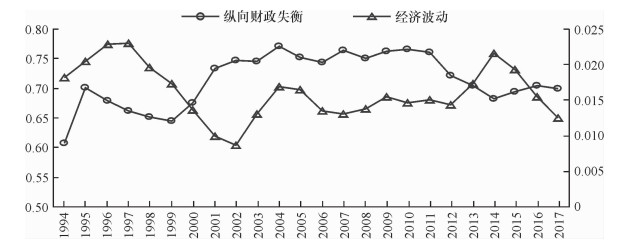Will Vertical Fiscal Imbalances Affect Economic Fluctuations: Evidence from China's Provinces since the Reform of Tax-sharing System
-
摘要: 财政政策是国家宏观调控的重要手段,但分税制改革引致的纵向财政失衡弱化了财政政策的调控作用。基于中国1994—2017年29个省份的面板数据,对纵向财政失衡与经济波动之间的关系进行实证分析,发现纵向财政失衡是导致我国经济波动的重要因素,并通过投资冲击、技术冲击和货币供给冲击等途径对经济波动产生正向促进作用;纵向财政失衡对经济波动的影响存在时序异质性和环境异质性;纵向财政失衡的变化周期先于经济波动的变化周期,并呈现一定的周期同步性。Abstract: Fiscal policy is an important means of national macro-control. However, the vertical fiscal imbalance caused by the tax-sharing reform has weakened the regulatory role of fiscal policy. Based on the panel data of 29 provinces (municipalities and autonomous regions) from 1994 to 2017 in China, this paper uses the dynamic panel model to empirically analyze the relationship between vertical fiscal imbalance and economic fluctuations.The results show that vertical fiscal imbalance is an important factor leading to China's economic fluctuations; it also positively promotes economic fluctuations through investment shocks, technological shocks and money supply shocks. There are temporal heterogeneity and environmental heterogeneity in the influence of vertical fiscal imbalance on economic fluctuation; the change cycle of vertical fiscal imbalance precedes the change cycle of economic fluctuation and presents a certain cycle synchronization.
-
表 1 主要变量描述性统计
Variable Obs Mean Std. Dev. Min Max Gdpf 696 0.016 1 0.009 7 0.001 5 0.084 2 IS 696 0.100 2 0.080 0 0.008 1 0.701 4 TS 696 0.155 3 0.121 3 0.021 3 1.228 7 MS 696 0.035 0 0.028 7 0.003 2 0.121 7 VFI 696 0.713 6 0.172 2 0.163 7 0.954 6 Open 696 0.324 5 0.612 8 0.016 9 12.805 5 Finance 696 1.095 8 0.391 0 0.000 1 2.584 7 Indus 696 0.976 7 0.459 9 0.497 1 4.236 7 Labor 696 8.087 5 1.291 0 0.777 4 12.502 5 Unemploy 696 3.372 0 0.820 3 0.410 0 6.500 0 表 2 纵向财政失衡与经济波动基准回归结果
基准回归 稳健性检验 内生问题处理 方程(1) 方程(2) 方程(3) 被解释变量滞后一期 0.781 6*** (40.01) 0.480 5*** (14.76) 0.791 8*** (34.62) VFI 0.032 6*** (5.07) 0.026 0** (2.23) 0.025 3*** (3.92) Open 0.002 5*** (3.46) 0.014 1*** (3.16) 0.004 4*** (4.63) Finance 0.001 3** (2.01) 0.024 2*** (6.92) -0.002 4* (-1.81) Indus 0.000 6 (1.17) -0.036 3*** (-8.84) 0.000 9 (0.84) Labor -0.000 2 (-0.93) -0.001 5* (-1.69) 0.001 1** (3.23) Unemploy -0.003 4*** (-4.37) -0.006 1*** (-3.69) -0.002 2*** (-3.59) C -0.009 6*** (-2.77) 0.018 4* (1.81) -0.003 6 (-0.5) AR(1) 0.045 0.002 AR(2) 0.178 0.068 Hansen test 0.789 0.907 R2 0.6769 弱工具变量检验 185.617 注:括号内为z统计量;*、**、***分别代表 10%、5%、1%的显著水平。表 3、表 4同 表 3 纵向财政失衡影响经济波动的中介效应检验结果
方程(4) 方程(5) 方程(6) 方程(7) 方程(8) 方程(9) 中介效应 投资冲击 技术冲击 货币供给冲击 被解释变量 IS Gdpf TS Gdpf MS Gdpf 估计步数 第二步 第三步 第二步 第三步 第二步 第三步 被解释变量滞后一期 0.820 9*** 0.645 1*** 0.137 9*** 0.888 8*** 0.840 8*** 0.755 0*** (30.00) (31.91) (3.83) (33.23) (77.27) (20.26) VFI 0.068 8*** 0.006 9*** 0.117 7*** 0.006 8** 0.014 9*** 0.009 8*** (6.96) (3.57) (4.14) (2.40) (7.65) (5.73) Open 0.006 9*** 0.000 3 0.003 7* 0.000 7*** 0.002 3*** 0.001 3*** (6.16) (1.58) (1.66) (3.45) (4.55) (3.28) Finance 0.006 7*** -0.000 2 0.003 3 -0.000 2 -0.000 8* 0.000 2 (2.84) (-0.36) (0.36) (-0.42) (-1.68) (0.32) Indus -0.005 9*** -0.001 1** 0.062 0*** -0.002 0*** -0.000 8 -0.000 9 (-2.94) (-2.45) (4.54) (-4.77) (-1.44) (-2.43) Labor 0.004 2*** 0.001 4*** -0.026 9*** 0.001 3*** 0.000 4*** 0.001 2*** (4.49) (12.43) (-12.24) (9.39) (3.67) (9.46) Unemploy -0.003 3* 0.000 1 0.009 9*** -0.000 7*** -0.000 4 0.000 1 (-1.79) (0.27) (4.86) (-3.02) (-1.09) (0.35) Shock 0.060 7*** 0.016 1*** 0.053 2*** (15.09) (10.74) (6.90) C -0.063 7*** -0.015 7*** 0.166 1*** -0.012 1*** -0.009 5*** -0.015 2*** (-3.41) (-7.04) (4.12) (-3.97) (-3.57) (-6.94) AR(1) 0.000 0.001 0.005 0.001 0.000 0.001 AR(2) 0.864 0.325 0.791 0.531 0.117 0.111 Hansen test 0.980 0.962 0.103 0.945 0.484 0.971 表 4 纵向财政失衡对经济波动影响的异质性检验回归结果
时序异质性 环境异质性 1994—2001 2002—2017 高 低 被解释变量滞后一期 0.683 9***(8.67) 0.677 9*** (9.58) 1.105 1*** (25.62) 1.252 8*** (21.89) VFI 0.048 0** (2.35) 0.024 3* (1.95) 0.019 1* (1.72) 0.064 6*** (3.06) Open 0.011 0* (1.86) 0.007 4** (2.00) 0.000 7* (1.91) 0.000 8 (0.19) Finance 0.026 8*** (2.58) 0.001 1 (0.90) 0.001 6 (0.90) -0.003 1** (-2.39) Indus -0.051 3*** (-3.95) -0.000 9 (-1.30) -0.001 3** (-2.01) -0.001 4 (-1.08) Labor -0.001 4 (-0.35) 0.001 6** (2.04) 0.001 6*** (3.01) 0.000 1 (0.58) Unemploy -0.009 3* (-1.81) 0.000 9*** (2.58) -0.000 7 (-0.98) -0.001 6** (-2.47) C 0.026 9* (1.83) -0.033 2* (-1.90) -0.026 5** (-2.50) -0.047 2*** (-3.04) AR(1) 0.021 0.030 0.009 0.006 AR(2) 0.401 0.155 0.055 0.077 Hansen test 0.229 0.465 0.131 0.161 -
[1] JONES J B. Has fiscal policy helped stabilize the postwar U. S. economy?[J]. Journal of Monetary Economics, 2002, 49(4): 709-746. doi: 10.1016/S0304-3932(02)00113-7 [2] GALI J. Government size and macroeconomic stability[J]. European Economic Review, 2006, 50(5): 1339-1346. doi: 10.1016/j.euroecorev.2005.03.007 [3] LEE Y, SUNG T. Fiscal policy, business cycles and economic stabilization: evidence from industrialized and developing countries [J]. Fiscal Studies, 2010, 28(4): 437-462. http://www.researchgate.net/publication/228811746_Fiscal_Policy_Business_Cycles_and_Economic_Stabilization_Evidence_from_Industrial_and_Developing_Countries/download [4] DEBRUN X, KAPOOR R. Fiscal policy and macroeconomic stability; automatic stabilizers work, always and everywhere[J]. Social Science Electronic Publishing, 2010, 10(111): 1-46. http://papers.ssrn.com/sol3/papers.cfm?abstract_id=1620245 [5] FATAS A, MIHOV I. The case for restricting fiscal policy discretion[J]. The Quarterly Journal of Economics, 2003, 118(4): 1419-1447. doi: 10.1162/003355303322552838 [6] MOHANTY M S, ZAMPOLLI F. Government size and macroeconomic stability[J]. Bis Quarterly Review, 2009, 38(1): 117-132. [7] FERNANDEZVILLAVERDE J, GUERRONQUINTANA P, KUESTER K, et al. Fiscal volatility shocks and economic activity[J]. American Economic Review, 2015, 105(11): 3352-3384. doi: 10.1257/aer.20121236 [8] 石柱鲜, 赵红强, 孙皓. 中日韩经济周期波动及其主要影响因素分析[J]. 现代日本经济, 2011(2): 10-17. doi: 10.3969/j.issn.1000-355X.2011.02.002 [9] 周宙, 魏杰. 政府宏观经济政策与经济波动的关系——经济失衡形成和传递机制的分析及对中国数据的考量[J]. 经济学动态, 2015(4): 23-34. https://www.cnki.com.cn/Article/CJFDTOTAL-JJXD201504004.htm [10] 周业安, 章泉. 财政分权、经济增长和波动[J]. 管理世界, 2008(3): 6-15. https://www.cnki.com.cn/Article/CJFDTOTAL-GLSJ200803005.htm [11] 康锋莉, 艾琼. 财政分权、地方政府行为与经济绩效[J]. 财贸研究, 2011(1): 73-80. doi: 10.3969/j.issn.1001-6260.2011.01.011 [12] 龚旻, 张帆. 中国地方政府的"相机抉择依赖症"与地区经济波动[J]. 当代财经, 2015(3): 3-12. https://www.cnki.com.cn/Article/CJFDTOTAL-DDCJ201503002.htm [13] 李猛, 沈坤荣. 地方政府行为对中国经济波动的影响[J]. 经济研究, 2010(12): 35-47. https://www.cnki.com.cn/Article/CJFDTOTAL-JJYJ201012004.htm [14] 邓明, 魏后凯. 公共支出结构偏向的经济波动效应研究——兼论新常态下的公共支出结构调整[J]. 经济管理, 2015(9): 166-177. https://www.cnki.com.cn/Article/CJFDTOTAL-JJGU201509020.htm [15] 陈利锋. 政府支出的构成与中国经济波动——基于动态随机一般均衡模型的分析[J]. 南方经济, 2016(4): 1-23. doi: 10.3969/j.issn.1000-6249.2016.04.001 [16] 桑百川, 黄漓江. 政府支出与经济波动——基于省级面板数据的实证分析[J]. 南方经济, 2016(8): 60-74. doi: 10.3969/j.issn.1000-6249.2016.08.005 [17] 唐志军, 刘友金, 谌莹. 地方政府竞争、投资冲动和我国宏观经济波动研究[J]. 当代财经, 2011(8): 8-18. https://www.cnki.com.cn/Article/CJFDTOTAL-DDCJ201108003.htm [18] 沈坤荣. 新一轮中国经济波动中的"黄灯效应"[J]. 现代经济探讨, 2004(9): 7-8. doi: 10.3969/j.issn.1009-2382.2004.09.002 [19] 郭庆旺, 赵旭杰. 地方政府投资竞争与经济周期波动[J]. 世界经济, 2012(5): 3-21. https://www.cnki.com.cn/Article/CJFDTOTAL-SJJJ201205004.htm [20] 杨灿明, 詹新宇. 中国宏观税负政策偏向的经济波动效应[J]. 中国社会科学, 2016(4): 71-90. https://www.cnki.com.cn/Article/CJFDTOTAL-ZSHK201604005.htm [21] 蔡宏波, 王俊海. 所得税与中国宏观经济波动——基于动态随机一般均衡模型的拓展研究[J]. 经济理论与经济管理, 2011(11): 39-46. doi: 10.3969/j.issn.1000-596X.2011.11.005 [22] 项后军, 巫姣, 谢杰. 地方债务影响经济波动吗[J]. 中国工业经济, 2017(1): 43-61. https://www.cnki.com.cn/Article/CJFDTOTAL-GGYY201701004.htm [23] 饶晓辉, 刘方. 政府生产性支出与中国的实际经济波动[J]. 经济研究, 2014(11): 17-30. https://www.cnki.com.cn/Article/CJFDTOTAL-JJYJ201411003.htm [24] 戴魁早. 要素市场扭曲如何影响出口技术复杂度?——中国高技术产业的经验证据[J]. 经济学(季刊), 2018(1): 337-366. https://www.cnki.com.cn/Article/CJFDTOTAL-JJXU201901015.htm [25] 黄漓江, 桑百川, 郭桂霞. 贸易开放、贸易市场多样化与经济波动——基于中国省级面板数据的实证分析[J]. 国际贸易问题, 2017(8): 3-15. https://www.cnki.com.cn/Article/CJFDTOTAL-GJMW201708001.htm [26] 林春, 孙英杰. 分税制改革下纵向财政失衡与全要素生产率损失[J]. 华中科技大学学报: 社会科学版, 2019(1): 83-91. https://www.cnki.com.cn/Article/CJFDTOTAL-HZLS201901012.htm [27] 孙英杰, 林春. 中国普惠金融发展的影响因素及其收敛性——基于中国省级面板数据检验[J]. 广东财经大学学报, 2018(2): 89-98. https://www.cnki.com.cn/Article/CJFDTOTAL-SONG201802009.htm [28] 邵军, 徐康宁. 转型时期经济波动对我国生产率增长的影响研究[J]. 经济研究, 2011(12): 97-110. doi: 10.3969/j.issn.1002-5863.2011.12.044 [29] 缪小林, 伏润民, 王婷. 地方财政分权对县域经济增长的影响及其传导机制研究——来自云南106个县域面板数据的证据[J]. 财经研究, 2014(9): 4-15. https://www.cnki.com.cn/Article/CJFDTOTAL-CJYJ201409001.htm [30] 刘清杰, 任德孝. 中国地区间税收竞争刺激经济增长了吗[J]. 广东财经大学学报, 2017(4): 92-103. https://www.cnki.com.cn/Article/CJFDTOTAL-SONG201704009.htm [31] 万春, 许莉. 我国农村公共服务供给制度改革的演进轨迹[J]. 金融教育研究, 2018(6): 14-19. https://www.cnki.com.cn/Article/CJFDTOTAL-JXJR201806002.htm [32] 付敏杰. 市场化改革进程中的财政政策周期特征转变[J]. 财贸经济, 2014(10): 17-31. https://www.cnki.com.cn/Article/CJFDTOTAL-CMJJ201410003.htm [33] HE Q, XUE C, ZHU C. Financial development and patterns of industrial specialization: evidence from China[J]. Review of Finance, 2017, 21(4): 1593-1638. -





 下载:
下载:

